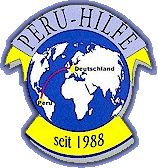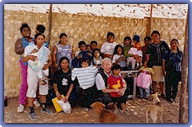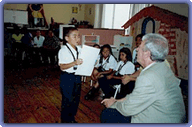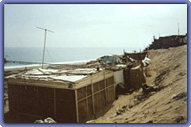CDG-FH- Programme 'Practical Semester In A Foreign Country' in Summer Term 2002 by Susanne Müller
(20.05.2011)
A Personal Aspect1. My observation of intercultural differences
My temporary change of domicile from an industrialised Germany to a less developed Peru was like a transition into another world. This idea was formed in my head by the contact with people of very different characters and by my adjustment to their style of living. It was interesting to get to know their way of thinking and to understand these. Through dialogues and group discussions I found explanations for their actions.
How do I have to behave?
At the beginning of my stay in Peru I was not sure how to behave towards other persons and in certain situations. I did not know how to show respect to persons. In Peru more respect is shown towards older people than in Germany. In every culture the ceremony of welcoming and saying goodbye is different. With time I got used to the 'duties' of everyday life and adjusted myself to their culture.
School-Training-Work
People of the higher class told me their reason for long working-days and additional work on other projects: to create a better future for their children. The difference between our countries lies in the competition between children, students and employees. Because of the high birth rate in Peru competition between people is much stronger. There are difficulties, for example, to get a job or to get a scholarship! Only the most qualified and the most prepared children have a chance on the labour market. Of course there are public national schools. These are not comparable with the expensive private schools paid by parents. Here a class consists of twenty children whereas a class in a public school has forty or more children. Foreign languages are promoted more strongly, too. Only through a good school education a child is able to pass an entrance examination of a well-known university. Of course every course you are enrolled for has to be paid by the parents. The student does not have the possibility to get Bafög (financial support for German students by the state). Because of the name of the university and the parents's contacts the graduates get a job. I remember a conversation with the parents of eight-months-old twins. They were still thinking about having a third child. They were concerned about money problems, not of the purchase of a children's furnishings, but because of the payment of an education.
The Meals
Another very interesting difference to our culture is the nutrition of people. Dependent on the areas of Peru (coasts, mountains, jungle) and on the standard of living of the people the food and its preparations differ. Mainly self-cultivated products are consumed. At the coast fish and rice are eaten. In the mountains sweet corn, potatoes, vegetables stew, guinea pigs, alpacas and llamas are served. The cheapest products in the rainforest is fruit. For breakfast I had a freshly pressed juice, a bun with marmelade, cheese, olives, egg or avocado. The amount was not enough for me most of the time. Lunch was between 1:30 or 2:00 p.m. . For my attitude too late. A soup, a main dish and a fruit was serverd. For dinner, between 7:00 and 9:00 p.m., I had bread with one of the spreads of the breakfast.
The Housekeeper
In a household of the middle or a higher class of society always works a housekeeper. She often sleeps on the attic in the same house. She is paid monthly, gets free meals and has one days off every week, usually Sunday. The housekeeper is responsible for the preparation of all meals for the family, for the cleaning of the house and for washing the clothes. When she serves a meal she is the last one to get the same meal. She eats her meal in the kitchen. When all family members leave the house during the day, the apartement is trusted to her. I think that Germans here are too suspicious. In Peru the housekeeper is never treated as an inferior person, but is spoken to with regard and respect. In a small apartement she only works by the hour and is paid correspondingly (without staying overnight or having a meal).
Recycling
Another remarkable difference to the German culture is the usage of what we might call 'garbage'. Peruvians ride on their bikes with trailers through the streets and call for metal things, bottles, plastic or paper. Everyone collects other things which later are sold or reused.
Secureness or boundary?
The higher class of society which only makes out a small part of Peru's population pays for its secureness. This means, for example, that every street has two 'watchmen' (security guards). They work by turns in day or night shifts. I even saw a lot of policemen guarding the parks in the richer areas by night and day. There are housing areas which are fenced and are fitted with guards and cameras. In so-called 'clubs' only members are allowed. These clubs offer leisure time facilities: squash, swimming, tennis, volleyball and much more. This is their everyday life and secureness is not seen as a sign of prestige like in Germany.
Equal Rights
I question myself about equal rights in the Peruvian culture. Through conversations with 'richer' people it was made clear to me that these people want to live in a certain luxury in their country, although Peru is fitted in public with a lower standard of living. Is it not their right to create their own surrounding with the money they earned by themselves without hurting any people? Today I think the difference in the way of living can no longer be seen as an injustice, but as a credit of their work (but also as fortune to be born into such a family).
2. My personal development
In Everyday Life
At the beginning of my stay I had been insecure about my behaviour towards the Peruvians and my language skills. Today I know how to interact with people, to address them accordingly to their position in society. It is an exercise to talk adequately to important persons in Spanish.
At Work
I have learnt how to coordinate and or organise in a better way. In a project every team member is dependent on the other and vice versa. To cooperate successfully the agreement has to work and tolerance has to be there. I have learnt to accept people with their mistakes and to respect them, only with this a cooperation is possible.
3. My Progress in Language
Because I spent my time in a Spanish-speaking country I depended completely on my language skills.
Communication
The exclusively contact to Peruvians made it easier to improve my Spanish. In dialogues I was challenged to understand my partner in dialogue and to answer accordingly. Conversation in groups were more difficult for me because more people spoke at the same time. They used colloquial speech and expressions which were not listed in my dictionary. Through exercising and observation I was able to take part in group talks.
Literature
I provided myself with Spanish literature: novels, secondary literature, tragedies, fairy tales, grammar books and much more. For me it is interesting to learn new Spanish expressions and how the language is used in different works of literature.
Everyday Life
With every day I improved my Spanish skills: when I cooperated with colleagues, went to the cinema, read newspapers, talked to friends or simply listened to a conversation between other people.
B Functional Aspect
1. My Function in Staying Abroad
1.1 Practical Training in Pamplona
Introduction of the Project
The project I am working at is called ' The reception of iron and cink' This project is a cooperation of different universities in the US (University of California, University of Colorado, Denver) and the Institute for Food Research.
Aim of the Project
Aim of the project was to define the best amount of iron and cink which are bound to be supplied to be absorbed at its best by a body of a child with a lack of iron and cink (three or four-years-old or eleven-months-old).
Description of my Area of Work
The project was carried out in 'Pamplona Alta'. This is one of the poorest areas in Lima. There is almost no vegetation, only rocks and sand. The houses of the inhabitants are built with rush mats, clingwraps, steel plates and wooden shelves. Everything that can be found or bought cheaply is used for buildung. Every family owns one of this 'houses' with one room or sometimes more rooms which are divided from each other by waste fabrics. The floor is for the most part the same sand as in the streets. There is almost no furnishing. One bed is used be two or three people. They often have one table. Upside down containers or canisters are used as a possibility to sit down. Not every family member owns a plate, a cup or cutlery. There is electricity in almost every house, but not running water. Every day delievery vans distribute water which is kept in containers by the family. The water out of the containers is used for cooking, drinking, washing the clothes as well as for washing the dishes. Because of the lack of hygiene parasites and germs often settle themselves. The families in 'Pamplona Alta' are very young. The newlywed couples from the mountains settled in Lima four or five years ago. Every couple in 'Pamplona Alta' laid a claim on a piece of land and built its own house. Most of the children are born there and are not older than five years.
Affilation criteria for the project
Children which are three or four-years-old or eleven-months-old are incorporated into the project. Nurses go from house to house to define the height and the weight of these children. An important aspect to be incorporated into the project is the height. Likewise the iron content in the blood is measured. Only children with an iron content of 8-10,9 g per decilitre blood are allowed to enter the project. Healthy people have an iron content of 12-14 g per decilitre blood. Altogether 60 children are looked for to participate in this project for a time of three months.
Enriched Food
For the children special food is prepared. There are three different kinds of diets each with different amounts of nutriments. It is alloted which children get which food. Food Number One consists of cookies and pasta made out of wheat flour which in enriched with three milligramme of iron per 100g flour. The flour which is sold in Peru has the same amount of iron. In Food Number Two the wheat flour is enriched with three milligramme iron and three milligramme cink per 100 g flour. 100G wheat flour with three milligramme iron and nine milligramme cink is the concentration of Food Number Three. The cookies and the pasta are specially produced in a labatory.
Realisation of the Project
Eleven weeks = 64 days
Lessons in Nutriton
On the last day of the project the parents, most of the time only the mothers showed up, have a lesson in nutrition. The parents are taught how to nourish their family and themselves in a healthy way. In the majority of cases not only there is a lack of money to buy food but also a lack of knowledge how to prepare a meal correctly.
Evaluation of my Function in this Project
In this project I have learnt a lot about the food in Peru. Staple food like quinua, amaranto and kamote are not known in Germany. Quinua is a food very rich in protein which features a better composition of amino acids than meat. Nevertheless it has not been possible to stop the malnutrition in Peru. I have learnt to orient myself in a foreign, very poor area and to work together with its people. Without their help, especially those of the mothers, the project would not have been possible. Among each other we have to coordinate ourselves in the project and when problems appear we have to consult the families together, because every person carries out an aspect of the project and lies the cornerstone for the colleagues's next step. Team spirit, cooperation and understanding have to be there. In the lessons in nutrition Ihave learnt, for example, how to prevent anemia. The following food contains a high amount of iron: liver, fish, eggs, spinach and lentils. These should be combined with lemons, oranges, tangerines or papayas. The vitamin C in this fruit supports the absorption of iron in our body. Black tea and coffee reduce the absorption of iron into blood.
1.2 Practical Training in Trujillo
Introduction of the health Centres in Trujillo
In April I worked in four different health centres in Trujillo. 'Vista Alegre' and 'Larco Mar' are situated in the centre of the city. Accordingly the institutions are more modern and fitted with enough staff. A personal relationship between staff and patients does almost not exist. 'Gran Chimu' and 'Pesqueda 3' are health centres at the border of Trujillo. The inhabitants in those areas are poorer than those living in the centre of Trujillo. The health institutions are fitted out with little utensils. But I was able to observe that the doctors, nurses and nutrionists had established a personal relationship to their patients.
Disposition of height and weight of the children
Preparation of food
Home visits
Evaluation of my Practical Training in Trujillo
In Trujillo I learnt to deal a lot better with small children. To find out about their height and weight I had to show a lot of patience. The methods of disposition are old-fashioned but convenient and useful. The home visits showed me under what conditions people live. Therefore I now understand their problems better. It is interesting to compare the private hospitals in Lima with the health centres in smaller towns. In Trujillo people are supplied with considerably less modern utensils in less room, but they get their treatment for free or cheaper unlike the patients in private hospitals. The usage of computers or of other technical auxiliary materials is restricted for nutrionists in Trujillo. They manage themselves with simple conventional methods. This is the best method to work at an assignment in a developing country, because the most technical premises of industrial nations are not given. Without convenient thinking and the ability to find alternatives no results would be thinkable.
1.3 Practical Training in Lima - Cieneguilla
In Cieneguilla, a place close to Lima, the institution CIMA (= Centro de Integracion de Menores con Amor = Centre for integration of teenagers through love) is situated. This institution was founded by the Canadian Jean Lui de Bern twelve years ago. It houses 95 boys at the age of 9 to 18 who voluntarily come from the streets in Lima. The coordinator Astrit Montagne de Alemenara placed an order to us, Rosina Pareja, a nutrionist of the IIN, and me to set up a menu for those children for a month time. The average energy use of teenagers in their puberty is around 2500 calories a day. Every day 70 g of protein, 1300 milligramme of calcium, 11 g of iron and 11 mcg of vitamin A are needed per day. After these guidelines we made up 28 meals in each case of breakfast, lunch and dinner. We listed the condiments of the recipes, their ingredients, their energy content, their prices as well as their amount in every portion. Two times we visited the institution to lool how and by whom the meals are prepared. Because the hygienic circumstamces were not satisfactory we worked out hygienic recommodations and commodations for the storage of food for the kitchen staff. In Cieneguilla I weighed the meals consumed by the children. Every ingredient was defined particularly. So we were able to assert the original absorption of nutriments. Most of the time too much rice and too little animal products were consumed. They never had milk for breakfast what can lead to lack of calcium. With the help of our menu the kitchen staff receives detailed descriptions about ingredients and their use in meals. Thus the children get ideal and healthy food.
Evaluation of my practical Training in Cieneguilla
Through my work I have learnt about the combination of food. The work with just one person is organisationally easier than the cooperation with more people. However, we two were totally dependent on each other. The Peruvian recipes are very different than the German recipes. Staple food of the 28 elaborated meals is rice which is in my opinion not an ideal nutrition. But because the teenagers have been used to eat rice since their childhood and they did not accept any other alternatives we had to add rice to our menu. To German teenagers I would have offered more potatoes.
The Comparison of my Evaluation with my Expectations Before Staying Abroad
Before going abroad I only had a few expectations. I thought it was better to start my practical training without any fixed expectations. I dealt with a situation when it happenend. The chance to be disappointed is less. My expectations were to get to know a foreign culture with its tradition and to try to adjust to its way of living. Likewise the native food was interesting for me. I questioned myself: how are the products cultivated? How are they prepared? How is the general situation of nutrition in Peru or in the Andes? Where is the difference to Germany? These questions I am able to answer now. I think my stay abroad was a success in matters of the response of my functional questions as well as in matters of getting to know and adjusting to a previously unknown culture.
3. The Evaluation of the Occupational Field of Budget Economics and the Food Industry in Peru
Despite the nutritious traditional food like quinua, amaranto, kanihua, oca, olluca, maca, chuno and mashua the population's situation of nutrition is inadequately. In infantile malnutrition caused by a deficit in iron, vitamin A and cink is no rarity. In school lessons nutrionists are able to inform children over healthy ingredients of the products of the Andes. The mothers are to trust in this food and are to learn how to prepare different recipes. Also the farmers of the Andes, the producers of these products, should be informed about the ingredients of the native crops and corms. Therevy production and consumption would be pushed on. Because of the poverty the education of the population has come to a stop on a low level. Mothers not only lack money but also the knowledge how to prepare a healthy meal. We budget economicists are able to teach mothers the right combination of food in meals. They are cleared up how to prevent anemia and deficits in vitamin A, iron and cink. They ought to be told that lemonades, sweets and ice cream is not proper food for their children.
C Future Prospects
My experiences in Peru are very useful for my future. After my practical training I am able to understand people better. I let myself willingly be corrected by them and I tolerate their opinions. My onesided perception of German nutrition with its problems has opened up. Today more opportunities of assignment are open to me as a budget economicist. The work with Peruvian people is very interesting and it is a lot of fun. It would be great to lead the people in this country further on to a healthy nutrition. I would like to get to know another foreign country with problems in nutrition. Only through a broader perception you are able to solve problems better. For me it is important to use my Spanish skills in my professional future. Likewise I want to improve my English to be able to also work optimally in this language. In February or March 2003 I am going to write my diploma thesis about 'The Quinua'. Therefore I need and look for a scholarship. My aim is to work with native people in Peru or in another country to live with them and to help them through my experiences and my knowledge.
Susanne Müller
Account Details.
Peru Hilfe
Konto 122 122 122 9
BLZ 370 697 20
VR-Bank Nordeifel eG
IBAN DE92370697201221221229
BIC GENODED1SLE
News
17.07.13
Training School …
08.01.13
School for …
19.06.11
Promoting Art …
19.06.11
Quarter of the Poor
At Christmas the Jesuits gave out toys out of our containers to more … mehr



